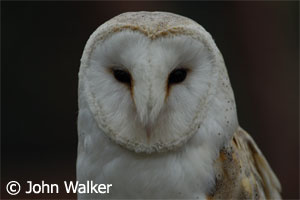Western Barn Owl Tyto alba schmitzi Hartert, 1900
Order: Strigiformes Family: Tytonidae Status: Breeding in Madeira



Western Barn Owl Field ID Keys
Shape & Size
A medium-sized owl with big head, long, rounded wings and short tail.
Colour Pattern
The subspecies schmitzi is endemic to Madeira and its darker colouring is the main distinctive feature from its nominate.
Barn Owl has a pale buff upperside with some grey and black spots at the back. It has a heart-shaped facial disc with dark feathers around its white face with black eyes. The underparts are very pale and lack the dark streaking or barring of most other owls.
Behavior
Barn owl is easy to identify by its strident call which normally does when flying. Its flight is light, agile with quick and deep wingbeats.
Habitat
Its common habitat is the open country from farmland to marshes with reedbeds though in Madeira Barn Owl is found on most parts of the island, generally not very high in altitude in a variety of habitats, from areas of human settlement, forest, agricultural fields, and areas with low vegetation to deep valleys.
This is the only nocturnal bird of prey breeding in Madeira archipelago and is found both in Madeira as in Porto Santo though it is scarcer in the latter.
Distinction from similar species
Being the only nocturnal bird of prey breeding in Madeira it should be easy to ID it though it has some similarities with the vagrant Short-eared Owl which is bigger, darker brown and with yellow eyes.
Tyto alba Biometrics
Wingspan: 33 - 35 cm (Beaman & Madge, 2011)
Total length: 85 - 93 cm (Beaman & Madge, 2011)
Weight: 290 - 460 g (Hume, 2002)
Other Bird Facts
Seasonality in Madeira: All year
Breeding: In Europe it typically nests in barns and other suitable buildings but in Madeira it is usual to choose large holes in cliffs, rocks or trees. It lays 4 to 6 white eggs in a single annual clutch. The eggs are incubated by the female alone while the male feeds her regularly.
Diet: In Madeira it hunts only at night, catching mainly rats, rabbits and road kills.
Status
Madeira local status by Correia-Fagundes et al, 2021: Rare breeding bird
Madeira local status by Romano et al, 2010: Rare breeding bird
Madeira local status by Zino et al, 1995: Common breeding bird
Conservation status by the IUCN Red List Categories, 2013: Least Concern ver 3.1
Name of this species in other languages
Portuguese: Coruja-das-torres, coruja-da-igreja
German: Schleiereule-schmitzi
Dutch: Kerkuil
Swedish: Tornuggla
Danish: Slørugle
Finish: Tornipöllö
Norwegian: Tårnugle
Spanish: Lechuza común
French: Effraie des clochers de Madère
Italian: Barbagianni
Polish: Płomykówka zwyczajna
Slovak: Plamienka madeirská
Czech: Sova pálená